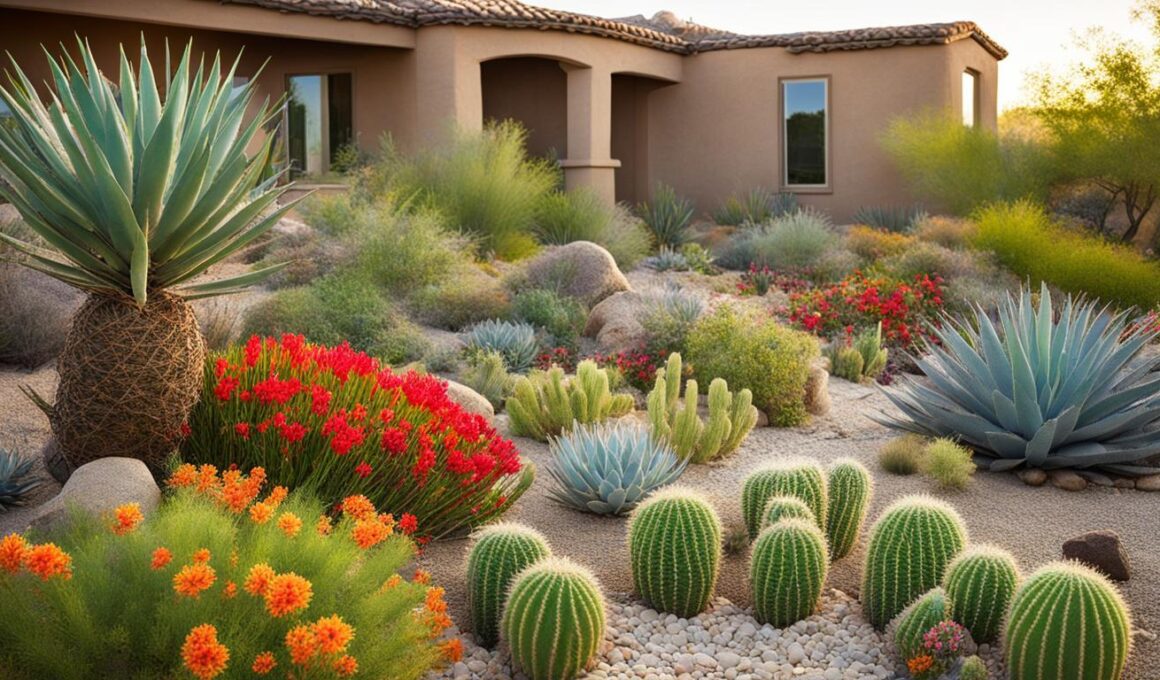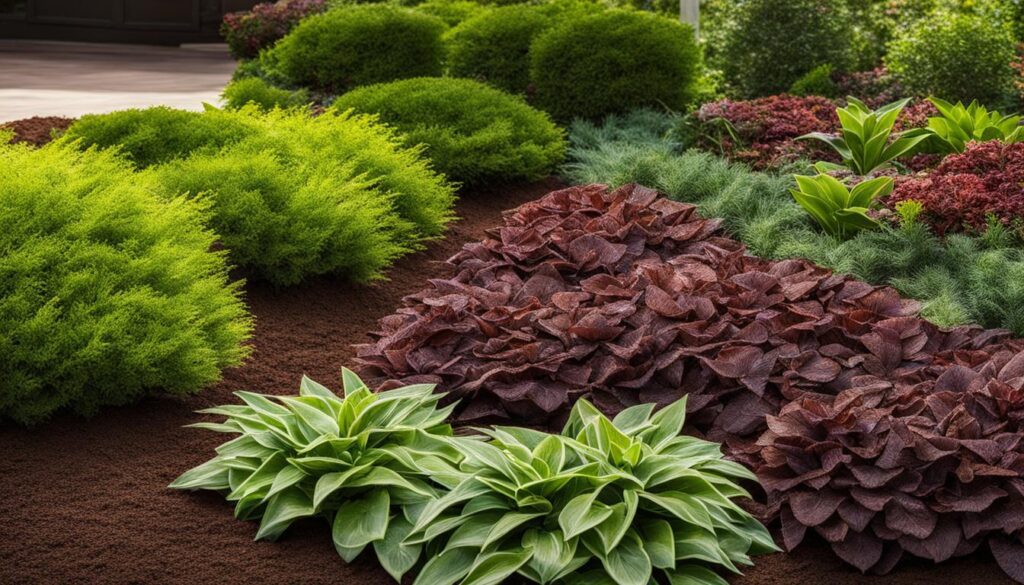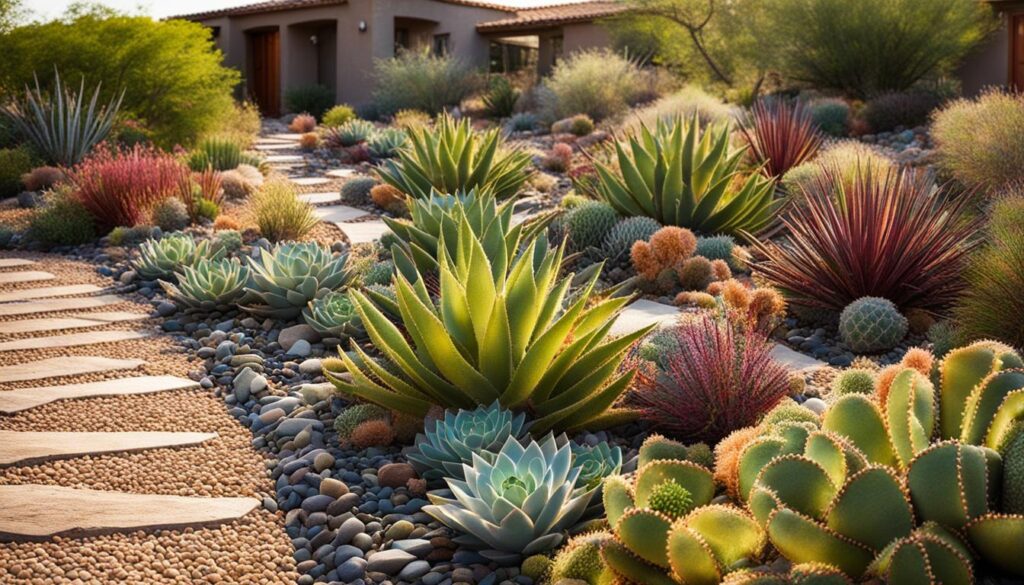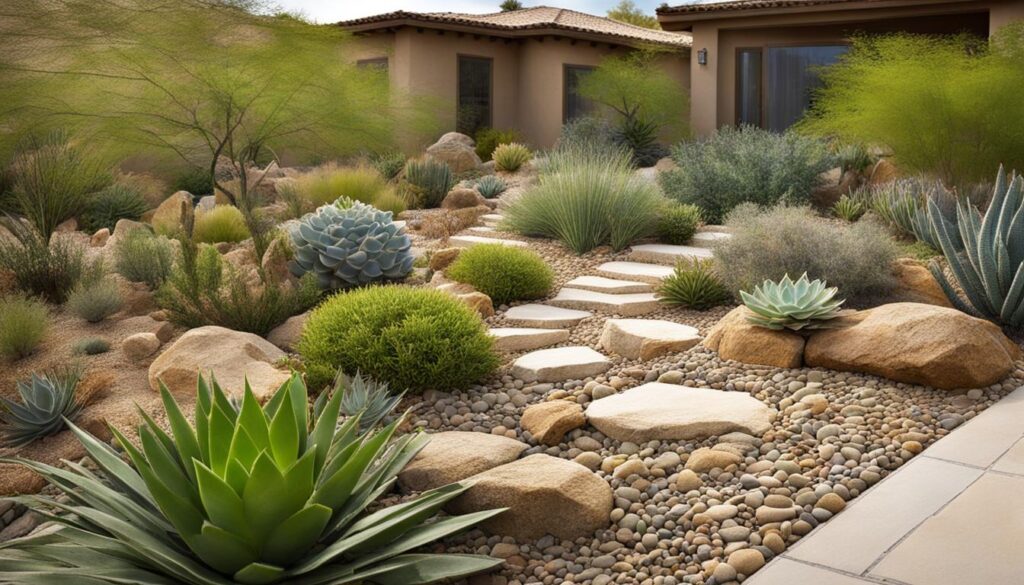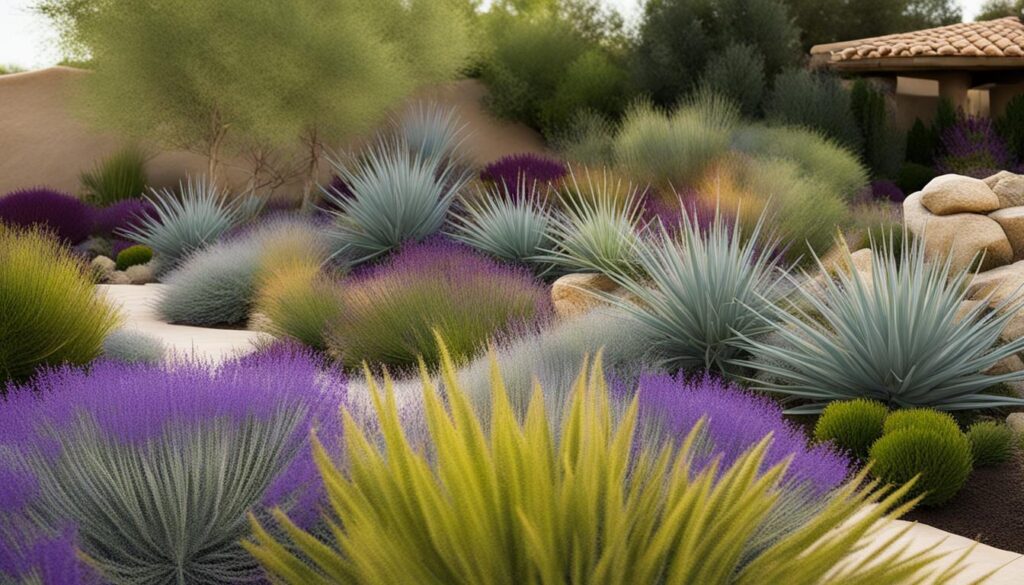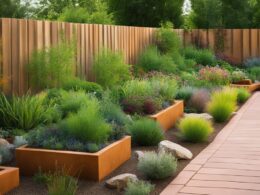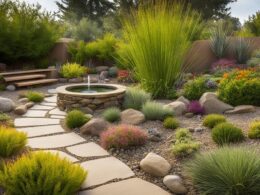Xeriscaping is the perfect solution for homeowners looking to create a beautiful and low-maintenance landscape in dry environments. This water-wise landscaping concept incorporates native plants, mulch, rocks, and drip irrigation systems to minimize water usage and enhance sustainability. If you’re new to xeriscaping, don’t worry! In this section, we’ll explore some simple design ideas that are perfect for beginners. By incorporating these ideas, you can transform your landscape into a stunning and sustainable oasis.
Key Takeaways:
- Xeriscaping is a water-wise landscaping concept that allows for beautiful and low-maintenance landscapes in dry environments.
- Incorporating mulch, replacing traditional lawns with drought-tolerant groundcovers, creating garden paths, and incorporating rock gardens are all simple design ideas for beginners.
- Utilizing mulch helps with moisture retention and improves soil fertility and structure.
- Drought-tolerant groundcovers are a great alternative to traditional lawns and require less water and maintenance.
- Garden paths not only add aesthetics but also provide functionality and water collection capabilities.
Utilize Mulch for Moisture Retention
Mulch is a crucial element in xeriscaping design as it serves multiple purposes. By utilizing mulch in your landscape, you can effectively retain moisture, improve soil fertility, prevent weed growth, and enhance the overall appeal of your outdoor space.
When it comes to choosing the right mulch for your xeriscaping project, there are various options available. Organic mulches, such as shredded bark or wood chips, provide excellent moisture retention and also break down over time, adding nutrients to the soil. Inorganic mulches, such as crushed stones or gravel, offer long-lasting benefits and are particularly suitable for rock gardens or Mediterranean-themed designs.
“Mulch plays a crucial role in xeriscaping by slowing down evaporation, improving soil fertility and structure, limiting weed growth, and adding curb appeal to your landscape design.”
Regardless of the type of mulch you choose, it’s important to opt for natural and clean options to ensure they are safe for the environment, soil, and wildlife. By incorporating mulch into your xeriscaping design, you can create a sustainable and visually appealing landscape that conserves water and reduces maintenance needs.
Types of Mulch for Xeriscaping
- Shredded bark
- Wood chips
- Crushed stones
- Gravel
- Rubber
- Straw
Xeriscaping Grass Alternatives: Embrace Drought-Tolerant Groundcovers
When it comes to xeriscaping, replacing traditional lawns with drought-tolerant groundcovers is a game-changer. Not only do these alternatives require less water, but they also add beauty and texture to your landscape. By choosing the right groundcovers, you can create a vibrant and low-maintenance garden that thrives even in dry conditions.
Creeping thyme is a popular choice for xeriscaping due to its ability to spread quickly and withstand drought. Its fragrant flowers attract pollinators while providing ground cover. Lantana is another excellent option, producing vibrant blooms in various colors and attracting butterflies. Silver carpet is a standout groundcover that forms a dense silver-green mat, adding a unique touch to your landscape.
For a grass-like appearance, consider incorporating low-lying sedum or creeping red fescue. These plants are hardy, require minimal water, and can tolerate poor soil conditions. Zoysiagrass is another great choice, known for its durability and ability to withstand foot traffic. By choosing these drought-tolerant groundcovers, you can reduce water consumption and enjoy a beautiful, sustainable landscape.
Benefits of Drought-Tolerant Groundcovers:
- Require less water than traditional lawns
- Add beauty and texture to your landscape
- Attract pollinators such as butterflies and bees
- Tolerate dry conditions and poor soil
- Reduce the need for mowing and maintenance
“By choosing the right groundcovers, you can create a vibrant and low-maintenance garden that thrives even in dry conditions.”
Choosing the Right Groundcovers:
When selecting drought-tolerant groundcovers, consider factors such as sunlight requirements, soil conditions, and the overall design aesthetic you want to achieve. Look for groundcovers that are native to your region, as they are more likely to thrive in your climate. It’s also essential to prepare the soil properly before planting, ensuring good drainage and fertility. By carefully choosing and preparing your groundcovers, you can create a resilient and visually appealing xeriscape that requires minimal water and maintenance.
Create Beautiful Garden Paths
Garden paths are an essential element of any well-designed xeriscape. Not only do they provide practical functionality, but they can also enhance the overall aesthetic appeal of your landscape. When designing eco-friendly walkways, it’s important to consider materials and construction techniques that promote water conservation and sustainability.
Materials for Xeriscaping Garden Paths
For a truly eco-friendly garden path, consider using permeable materials such as gravel, crushed stone, or porous pavers. These options allow rainwater to infiltrate the soil, reducing runoff and promoting water absorption. Additionally, these materials can be locally sourced, minimizing environmental impact from transportation.
Using permeable materials in your garden paths not only helps conserve water but also reduces the risk of erosion and flooding. It’s a win-win for both your landscape and the environment.
Design Considerations
When designing your garden paths, think about the overall layout and functionality. Create winding paths that encourage exploration and lead visitors to different areas of your landscape. Incorporate curves and meandering patterns to add visual interest and soften the overall look.
- Enhance the natural beauty of your garden paths by installing low-level lighting along the edges. Solar-powered lights are a great eco-friendly option.
- Add interest with border plants such as ornamental grasses, groundcovers, or low-growing perennials. These plants not only provide visual appeal but also help retain moisture in the soil.
- Consider incorporating stepping stones or flagstones to create focal points and lead the eye along the path.
By carefully selecting materials and design elements, you can create beautiful garden paths that not only enhance your xeriscape but also promote water conservation and sustainability.
Embrace the Beauty of Rock Gardens
A rock garden is an excellent addition to your xeriscaping design, providing both aesthetic appeal and practical benefits. By arranging boulders and rocks strategically, you can create stunning focal points in your landscape. Complement these rock formations with a variety of drought-resistant plants, such as cacti, succulents, wildflowers, and herbs. The combination of rocks and plants not only adds visual interest but also helps prevent evaporation and trap moisture in the ground.
To enhance the beauty of your rock garden, consider incorporating low-maintenance hardscape elements. Ground covers, like creeping thyme, lamium, creeping phlox, or campanula, can cascade over the rocks, adding color and texture to the landscape. These ground covers are resilient, requiring minimal watering and maintenance, making them ideal for xeriscaping. Additionally, they help suppress weed growth and reduce soil erosion, ensuring the longevity of your rock garden.
When designing your rock garden, take inspiration from natural rock groupings and recreate them in your own garden. Arrange the rocks in various sizes and shapes, creating a sense of depth and dimension. Consider using contrasting colors and textures to add visual interest. The placement of each rock should be purposeful, creating a natural flow within the garden. Combine different types of rocks, such as granite, limestone, or sandstone, to add diversity to your rock garden.
By embracing the beauty of rock gardens in your xeriscaping design, you can create a visually appealing landscape that requires minimal water and maintenance. The combination of rocks, drought-resistant plants, and low-maintenance hardscape elements will transform your outdoor space into a sustainable oasis.
Can Urban Xeriscaping Techniques Be Applied to Larger Landscapes?
Yes, master urban xeriscaping small spaces techniques can absolutely be applied to larger landscapes. By utilizing water-efficient planting and efficient irrigation methods, larger outdoor spaces can benefit from the same principles used in urban xeriscaping. With proper planning and design, even expansive landscapes can embrace sustainability and conservation practices.
Xeriscaping Design Ideas: Incorporate Mediterranean Flair
When it comes to xeriscaping, incorporating Mediterranean plants is a fantastic way to add beauty and sustainability to your landscape. These plants are well-suited for dry environments and can thrive in full sun and well-drained soils. With their vibrant colors, aromatic fragrances, and culinary uses, Mediterranean plants offer a unique flair to your xeriscape garden.
One popular choice is thyme, a drought-tolerant herb that not only adds visual appeal but can also be used in cooking. Its delicate leaves and fragrant scent make it a versatile addition to your xeriscape design. Another option is rosemary, a hardy evergreen shrub with needle-like leaves and beautiful flowers. It not only adds a touch of elegance to your landscape but is also known for its culinary uses, providing both flavor and fragrance to your dishes.
Oregano is another Mediterranean herb that thrives in dry conditions. Its tiny leaves and clusters of purple flowers create a lovely visual display, while its pungent flavor can enhance a wide range of dishes. Lastly, lavender is a popular choice for its striking purple flowers and calming fragrance. Not only does lavender add a touch of romance to your garden, but it can also be used in aromatherapy, helping to create a soothing and serene atmosphere.
“Incorporating Mediterranean plants in your xeriscape design will give your outdoor space a lovely and aromatic ambiance while reducing water consumption.”
By incorporating these drought-hardy herbs into your landscape, you can create an inviting and sustainable outdoor space. Whether you’re designing a small herb garden or adding Mediterranean elements throughout your xeriscape, these plants will add color, texture, and functionality to your landscape. Plus, with their adaptability to dry climates, they require less water, making them an eco-friendly and practical choice for any xeriscape garden.
Conclusion
In conclusion, xeriscaping is a sustainable and practical landscaping approach that allows you to create a stunning outdoor space while conserving water and minimizing maintenance. By incorporating simple xeriscaping design ideas like utilizing mulch, replacing traditional lawns, creating garden paths, incorporating rock gardens, embracing Mediterranean plants, and using drought-tolerant groundcovers, you can transform your landscape into a beautiful and eco-friendly haven.
Whether you live in a dry environment or simply want to reduce your water bills, xeriscaping offers a wide range of possibilities to create the perfect landscape while promoting sustainability and water conservation. By implementing these design ideas, you can not only save precious water resources but also enjoy a low-maintenance and visually appealing outdoor space.
With xeriscaping, you can create a landscape that thrives in harmony with nature, using native plants, efficient irrigation systems, and eco-friendly materials. By incorporating these principles into your landscaping, you not only contribute to a healthier environment but also create a sustainable and beautiful outdoor space that you can enjoy for years to come. So why wait? Start implementing xeriscaping design ideas and transform your landscape into a sustainable oasis today.





